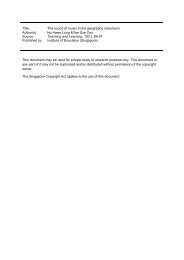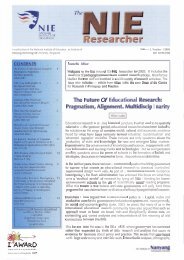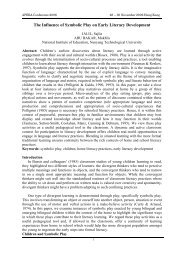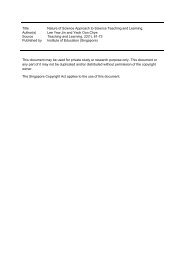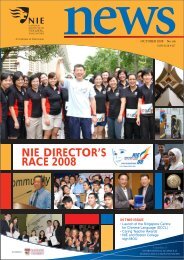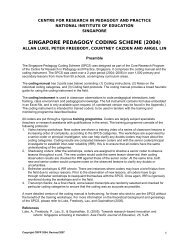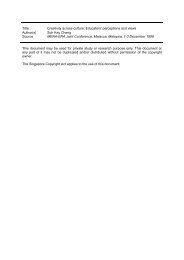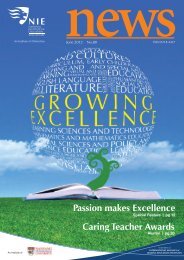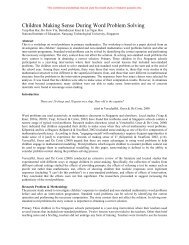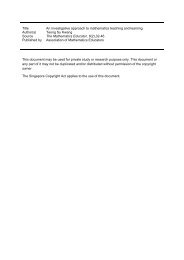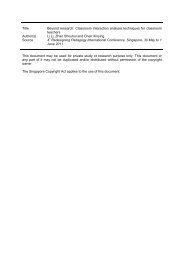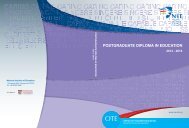12th International Congress on Mathematical Education (ICME-12 ...
12th International Congress on Mathematical Education (ICME-12 ...
12th International Congress on Mathematical Education (ICME-12 ...
You also want an ePaper? Increase the reach of your titles
YUMPU automatically turns print PDFs into web optimized ePapers that Google loves.
Title<br />
Author(s)<br />
Source<br />
Studies of high-quality teaching practice in mathematics: A comparative and<br />
collective analysis<br />
Jennifer M. Lewis, Douglas L. Corey and Yew Ho<strong>on</strong>g Le<strong>on</strong>g<br />
<str<strong>on</strong>g><strong>12</strong>th</str<strong>on</strong>g> <str<strong>on</strong>g>Internati<strong>on</strong>al</str<strong>on</strong>g> <str<strong>on</strong>g>C<strong>on</strong>gress</str<strong>on</strong>g> <strong>on</strong> <strong>Mathematical</strong> Educati<strong>on</strong> (<strong>ICME</strong>-<strong>12</strong>),<br />
Seoul, Korea, 8-15 July 20<strong>12</strong><br />
This document may be used for private study or research purpose <strong>on</strong>ly. This document or<br />
any part of it may not be duplicated and/or distributed without permissi<strong>on</strong> of the copyright<br />
owner.<br />
The Singapore Copyright Act applies to the use of this document.
<strong>12</strong> th <str<strong>on</strong>g>Internati<strong>on</strong>al</str<strong>on</strong>g> <str<strong>on</strong>g>C<strong>on</strong>gress</str<strong>on</strong>g> <strong>on</strong> <strong>Mathematical</strong> Educati<strong>on</strong><br />
Topic Study Group 21<br />
8 July – 15 July, 20<strong>12</strong>, COEX, Seoul, Korea<br />
STUDIES OF HIGH-QUALITY TEACHING PRACTICE IN<br />
MATHEMATICS: A COMPARATIVE AND<br />
COLLECTIVE ANALYSIS<br />
Jennifer M. Lewis<br />
Wayne State University<br />
jmlewis@wayne.edu<br />
Douglas L. Corey<br />
Brigham Young University<br />
corey@mathed.byu.edu<br />
Yew Ho<strong>on</strong>g Le<strong>on</strong>g<br />
Nati<strong>on</strong>al Institute of Educati<strong>on</strong>, Singapore<br />
Nanyang Technological University<br />
yewho<strong>on</strong>g.le<strong>on</strong>g@nie.edu.sg<br />
This paper presents comparative and collective analyses of research <strong>on</strong> classroom practice of high-quality<br />
mathematics instructi<strong>on</strong> across three studies of high-quality teachers: <strong>on</strong>e from Japan, <strong>on</strong>e from Singapore,<br />
and <strong>on</strong>e from the US. Across the three studies, we focus our analyses <strong>on</strong> the research methods and tools used<br />
in each study; the theoretical assumpti<strong>on</strong>s that frame each; and the high-quality practices identified by each<br />
study.<br />
Key words: Instructi<strong>on</strong>al practices; high-quality teaching; teacher learning; internati<strong>on</strong>al comparis<strong>on</strong>s.<br />
INTRODUCTION<br />
There is no doubt that images of high-quality mathematics instructi<strong>on</strong> are essential for<br />
guiding the educati<strong>on</strong> of preservice and inservice teachers towards instructi<strong>on</strong>al improvement.<br />
Yet little c<strong>on</strong>sensus exists around what c<strong>on</strong>stitutes high-quality mathematics instructi<strong>on</strong>. In<br />
this paper, we analyse three studies c<strong>on</strong>ducted in three different countries, by researchers who<br />
worked isolated <strong>on</strong>e from the other, using different methods and different data sources. One<br />
study examines the outcomes of discussi<strong>on</strong>s am<strong>on</strong>g teacher educators in Singapore who<br />
sought to articulate the features of high-quality mathematics instructi<strong>on</strong>. The sec<strong>on</strong>d study<br />
analysed videotaped less<strong>on</strong>s of three high-quality mathematics teachers in the US. The third<br />
study investigated the c<strong>on</strong>versati<strong>on</strong>s between Japanese “cooperating” or mentor teachers and<br />
student teachers as the student teachers prepared a less<strong>on</strong> plan. Although these studies<br />
represent divergent data sources, methods, and nati<strong>on</strong>al c<strong>on</strong>texts, the cross-study analysis<br />
yielded some compelling overlaps regarding c<strong>on</strong>ceptualizati<strong>on</strong> of high-quality instructi<strong>on</strong>.<br />
We c<strong>on</strong>sider each study in turn, and then look across the studies for patterns and similarities.<br />
1<br />
4215
Lewis, Corey, & Le<strong>on</strong>g<br />
IMAGES OF HIGH-QUALITY TEACHING IN SINGAPORE<br />
The Singapore team of teacher educators started the process of painting an image of high<br />
quality mathematics instructi<strong>on</strong> by describing certain features of such practices. This was<br />
meant to serve as a starting point in a c<strong>on</strong>versati<strong>on</strong> am<strong>on</strong>g Singapore mathematics teacher<br />
educators towards a set of comm<strong>on</strong>ly shared goals for Sec<strong>on</strong>dary mathematics methods<br />
courses. With these clearly articulated, teacher educators have a comm<strong>on</strong> language and<br />
framework to discuss about issues relating to high quality teaching; student teachers are<br />
presented with a clear set of criteria to serve as a goal that they can work towards in the<br />
process of the mathematics methods courses.<br />
Goal(s)-orientedness<br />
It is standard practice in mathematics methods courses that student teachers are expected to<br />
make explicit their instructi<strong>on</strong>al goals in written plans for their less<strong>on</strong>s. The basic rati<strong>on</strong>ale<br />
for such a practice is that <strong>on</strong>e is better able to realise where <strong>on</strong>e is going in a less<strong>on</strong> if there is<br />
a clear set of goals to work towards. Moreover, it is hardly possible to evaluate the success of<br />
a less<strong>on</strong> if there is no targeted end result to compare against.<br />
However, the point made here about goal-orientedness is not merely restricted to the act of<br />
stating a set of instructi<strong>on</strong>al objectives at the beginning of a less<strong>on</strong>. It is about teaching—all<br />
of it, and not just before a less<strong>on</strong>—that is guided by a focus towards the fulfillment of an<br />
achievable set of worthy instructi<strong>on</strong>al goals (including those that emerge during teaching),<br />
such that all teaching activities are deliberately geared towards the attainment of these goals.<br />
Trajectory of overarching mathematical c<strong>on</strong>cept(s)<br />
The language of “mathematical c<strong>on</strong>cept” is in part to present a c<strong>on</strong>trasting image against the<br />
unambitious teaching of ‘small ideas’, better known as teaching for facts and procedures<br />
without attempts to c<strong>on</strong>nect to the mathematical “Big Ideas” underlying these drills. In using<br />
the term “overarching”, the focus is <strong>on</strong> the need to pay attenti<strong>on</strong> to the central mathematical<br />
c<strong>on</strong>cept that acts as an organising frame—tying all the pieces within a unit of instructi<strong>on</strong>al<br />
practice. Thus, “trajectory of overarching mathematical c<strong>on</strong>cept(s)” places a demand <strong>on</strong><br />
student teachers to c<strong>on</strong>sider not just a presentati<strong>on</strong> of a sequence of steps in practice but also<br />
the deeper mathematical unifying c<strong>on</strong>cept undergirding them. The use of “trajectory” is<br />
meant to highlight the need not <strong>on</strong>ly to identify the overarching c<strong>on</strong>cept but also to carefully<br />
thread it through the entire practice; and not necessarily at <strong>on</strong>e-go, but maintained or build-up<br />
as the instructi<strong>on</strong>al unit unfolds.<br />
Also, more than <strong>on</strong>e overarching c<strong>on</strong>cept may be involved in a particular unit of<br />
instructi<strong>on</strong>. In this case, the student teacher is required to think of ways to weave these<br />
c<strong>on</strong>cepts together into a coherent trajectory.<br />
Active student engagement<br />
This point rests up<strong>on</strong> the principle that students’ learning in the classroom cannot take place<br />
unless they are vitally c<strong>on</strong>nected to the mathematical work that goes <strong>on</strong> in the milieu. While<br />
the choice of whether to engage in the work ultimately rests <strong>on</strong> the student, an important part<br />
of the teaching practice is to set up the instructi<strong>on</strong>al envir<strong>on</strong>ment that motivates students to<br />
engage productively in the mathematical work. Many research reports in the literature<br />
(especially those that are rooted in social-cultural theories) highlight the importance of active<br />
interacti<strong>on</strong> am<strong>on</strong>g students—such as small group discussi<strong>on</strong>s, students’ c<strong>on</strong>tributi<strong>on</strong>s to<br />
4216
Lewis, Corey, & Le<strong>on</strong>g<br />
whole-class talk, and collaborative investigati<strong>on</strong>s—as integral to their mathematical learning.<br />
(See, for example, Yackel & Cobb, 1996.) “Engagement” here is also broadened to include<br />
students’ quiet but deliberate study of learning materials that are carefully structured by the<br />
teacher. Ways to encourage engagements would include questi<strong>on</strong>ing and building up<strong>on</strong><br />
students resp<strong>on</strong>ses’ in public mathematical reas<strong>on</strong>ing during classroom discourses. It may<br />
also involve teachers’ c<strong>on</strong>sistent enforcement of c<strong>on</strong>templative quiet work and study as a<br />
valued dispositi<strong>on</strong> for mathematical thinking.<br />
Powerful representati<strong>on</strong>s<br />
Teachers do not just engage students verbally; they also use representati<strong>on</strong>s—in various<br />
media forms such as drawings <strong>on</strong> the whiteboard or projecti<strong>on</strong>s of computer screens—to help<br />
students focus visually <strong>on</strong> the discussi<strong>on</strong> track and sometimes even to provide hints for attack<br />
routes to mathematical problems. There are many representati<strong>on</strong>al forms comm<strong>on</strong>ly used in<br />
the mathematical domain: number line, tables, Venn diagrams, matrices, graphs, am<strong>on</strong>g<br />
others. One aspect to the work of teaching is to harness these representati<strong>on</strong>s appropriately to<br />
advance the mathematical agenda in the classroom.<br />
Representati<strong>on</strong>s that perform this functi<strong>on</strong> well are those that help the discussants summarise<br />
the salient points readily at a glance and thus helps to forward the discussi<strong>on</strong> in productive<br />
ways. In this way, the representati<strong>on</strong> can be said to be “powerful” as it projects the key<br />
elements of the discussi<strong>on</strong> in <strong>on</strong>e diagrammatic form to the students. Another c<strong>on</strong>cepti<strong>on</strong> of<br />
“powerful” representati<strong>on</strong> is that its use is not limited <strong>on</strong>ly to a <strong>on</strong>e-off or narrow domain;<br />
rather, the representati<strong>on</strong> can be adapted for use in other wider mathematical domains or as a<br />
tool for solving other problems.<br />
Suitable language<br />
That language plays a prominent role in mathematical learning is indisputable. From the<br />
social-cultural perspective, language is the medium for reas<strong>on</strong>ing. In the c<strong>on</strong>structivist<br />
paradigm, sense making starts from internal c<strong>on</strong>structi<strong>on</strong>s of meanings using informal<br />
language which becomes more refined over cycles of rec<strong>on</strong>structi<strong>on</strong>. Regardless of the<br />
theoretical stance <strong>on</strong>e takes <strong>on</strong> learning, it is clear that mathematical learning cannot be<br />
separated from the learning of suitable mathematical language. Thus, in c<strong>on</strong>sidering high<br />
quality instructi<strong>on</strong>, there is a need to include the weaving of appropriate language into<br />
classroom practice. This point is not merely about using correct mathematical terms in<br />
classroom talk; it is also about highlighting the importance of using mathematical language as<br />
an explicit learning goal for students. It is about the teacher using suitable mathematical<br />
language as well as helping students develop their use of mathematical language.<br />
Good use of time<br />
Often, student teachers are presented with innovative ways of teaching a particular<br />
mathematical topic; but because these approaches require significantly more time than is<br />
usually allotted in c<strong>on</strong>venti<strong>on</strong>al teaching schedules, they are viewed as not realistic as a<br />
regular feature of daily classroom teaching practice—but may remain as ‘boutique’ examples<br />
of practice that are seen as exotic. But the c<strong>on</strong>cepti<strong>on</strong> of high quality practice here is not<br />
restricted to those <strong>on</strong>ce-in-a-while situati<strong>on</strong>s; rather, it is a practice of quality that is<br />
sustainable as regular work of teachers in the classroom <strong>on</strong> a daily basis. As such, this noti<strong>on</strong><br />
of high quality practice must factor in the realistic and <strong>on</strong>going c<strong>on</strong>straints of classroom<br />
4217
Lewis, Corey, & Le<strong>on</strong>g<br />
practice. One major c<strong>on</strong>straint teachers face regularly is the time pressure. Thus, in<br />
c<strong>on</strong>sidering high quality teaching, we are not merely positing images of high quality teaching<br />
per se. Rather, we are proposing that we c<strong>on</strong>ceive of high quality teaching within the<br />
c<strong>on</strong>straints of good use of limited time.<br />
For the first time in the Sec<strong>on</strong>dary Mathematics methods course in the current intake of<br />
student teachers, these features were spelt out in the course documents as well as embedded<br />
into the criteria for assessment of their assignments. There are 84 student teachers<br />
participating in this course. As the course is <strong>on</strong>going, data and findings will be reported at a<br />
later stage. Nevertheless, the four tutors involved in the course (the third author being <strong>on</strong>e of<br />
them) met <strong>on</strong> a number of occasi<strong>on</strong>s to discuss how the re-designed course was progressing.<br />
There is c<strong>on</strong>sensus <strong>on</strong> the suitability of these features as criteria for assessing the student<br />
teachers’ assignment submissi<strong>on</strong>s.<br />
IMAGES OF HIGH-QUALITY TEACHING IN THE UNITED STATES<br />
This study analysed six videotaped less<strong>on</strong>s for each of three high-quality middle school<br />
mathematics teachers in the US. To qualify as a “high-quality teacher” for this study, teachers<br />
were first identified <strong>on</strong> the basis of their students’ achievement scores <strong>on</strong> standardized tests,<br />
their performance <strong>on</strong> standardized test items that assessed their mathematical knowledge for<br />
teaching or MKT (Hill, Schilling & Ball, 2004), and <strong>on</strong> the quality their observed instructi<strong>on</strong><br />
using an observati<strong>on</strong>al coding instrument (Learning Mathematics for Teaching Project, 2011).<br />
Six categories of instructi<strong>on</strong>al practice were identified that were comm<strong>on</strong> across these<br />
high-quality teachers: the use of precise mathematical language; the presentati<strong>on</strong> of<br />
mathematical representati<strong>on</strong>s that follow student thinking; attenti<strong>on</strong> to multiple mathematical<br />
proficiencies in single less<strong>on</strong>s; provisi<strong>on</strong> of scaffolding for students' development of<br />
mathematical ideas; c<strong>on</strong>duct of teacher-directed discussi<strong>on</strong>s that build mathematical ideas;<br />
and maintenance of routines that structure mathematical productivity.<br />
High-quality teachers use precise mathematical language<br />
Teachers used accurate and precise mathematical terms throughout their instructi<strong>on</strong>; their<br />
turns of talk were invariably dense with the use of mathematical terminology. Teachers<br />
frequently revoiced students' ideas using precise mathematical terms, and they revisited<br />
mathematical definiti<strong>on</strong>s often. The high-quality teachers in this set also seem to generate<br />
representati<strong>on</strong>s of mathematical problems as the need arises in class. While some of these<br />
representati<strong>on</strong>s come from the curricular materials teachers are using, many are produced as<br />
the less<strong>on</strong> unfolds. These teachers have a command of representati<strong>on</strong>s and can choose<br />
between different representati<strong>on</strong>al forms with ease and <strong>on</strong> the spot. Further, there is<br />
“meta-talk” about the advantages of a particular representati<strong>on</strong> in a given problem. This<br />
attenti<strong>on</strong> to the creati<strong>on</strong> of representati<strong>on</strong>s and the meta-discussi<strong>on</strong> about them is distinctive<br />
to this set of teachers.<br />
High-quality teachers attend to multiple mathematical proficiencies in a less<strong>on</strong><br />
Teachers traverse a range of “mathematical proficiencies” in their less<strong>on</strong>s. Across the less<strong>on</strong>s,<br />
we see teachers include a range of mathematical proficiencies, even those that are not<br />
specified in the curriculum. The model of "strands of mathematical proficiency" (Kilpatrick,<br />
Swafford, & Findell, Eds., 2001) served as an analytic framework to survey the various kinds<br />
4218
Lewis, Corey, & Le<strong>on</strong>g<br />
of mathematical work that the teachers in this sample engaged students in. These "strands of<br />
mathematical proficiency" were intended to capture "all aspects of expertise, competence,<br />
knowledge, and facility in mathematics" (p. 116). The strands are: c<strong>on</strong>ceptual understanding;<br />
procedural fluency; strategic competence; adaptive reas<strong>on</strong>ing; and productive dispositi<strong>on</strong>.<br />
The high-quality teachers observed weave in multiple strands of mathematical proficiency<br />
within a single less<strong>on</strong>, sometimes supplementing the curriculum materials to do so.<br />
High-quality teachers provide multiple scaffolds for students' mathematical thinking<br />
Teachers in this sample had multiple ways to scaffold students' mathematical thinking in the<br />
flow of instructi<strong>on</strong>. Five such scaffolding moves are: referencing relevant earlier work and<br />
ideas; checking in for student understanding; recalling simpler versi<strong>on</strong>s of a problem or idea<br />
to leverage higher or more advanced understandings; anticipating student misc<strong>on</strong>cepti<strong>on</strong>s;<br />
and attending to individual students with c<strong>on</strong>comitant differentiated instructi<strong>on</strong> <strong>on</strong>e-<strong>on</strong>-<strong>on</strong>e.<br />
High-quality teachers steer discussi<strong>on</strong>s to build mathematical ideas<br />
Teachers in this sample direct whole-class mathematical c<strong>on</strong>versati<strong>on</strong>s, and this occupies a<br />
good deal of time in their less<strong>on</strong>s. In these discussi<strong>on</strong>s of mathematical ideas, the teachers<br />
prompt students for c<strong>on</strong>tributi<strong>on</strong>s, and then work these student offerings towards a<br />
mathematical point the teacher is building. The students' c<strong>on</strong>tributi<strong>on</strong>s are somewhat<br />
circumscribed, the pace is brisk, and the teacher's talk dominates these discussi<strong>on</strong>s.<br />
Students' answers from the problems or experiments they do in class are starting points for the<br />
teacher's heavily guided discussi<strong>on</strong>s, in which teachers unpack student ideas and restate them<br />
in precise mathematical language, making them clear for collective reas<strong>on</strong>ing. Generally the<br />
string of student and teacher turns ultimately builds to a clear mathematical point articulated<br />
by the teacher. The kind of discussi<strong>on</strong> pattern seen is comm<strong>on</strong> across the teachers in this set,<br />
but the degree of directedness from the teacher, and the amount of student c<strong>on</strong>tributi<strong>on</strong>, vary<br />
with the c<strong>on</strong>tent being taught. In problems where students have more variati<strong>on</strong> in soluti<strong>on</strong><br />
strategies or ways to express reas<strong>on</strong>ing, the teachers will draw students' thinking out more and<br />
be less directive. In either case, though, the teachers remain in firm c<strong>on</strong>trol of the directi<strong>on</strong><br />
and pace of the c<strong>on</strong>versati<strong>on</strong>. There are few instances of student-generated discussi<strong>on</strong>s in the<br />
data; most c<strong>on</strong>versati<strong>on</strong>al exchanges are “student-teacher;” rarely are they “student-student,”<br />
to use Chapin, O’C<strong>on</strong>ner, and Anders<strong>on</strong>’s characterizati<strong>on</strong>s of interacti<strong>on</strong>s (2003).<br />
High-quality mathematics teachers structure class time with routines<br />
Teachers in this group were highly organized in the way they ran their less<strong>on</strong>s. There were a<br />
number of routines that teachers used to organize class time which enable a certain kind of<br />
mathematical press. For example, teachers had overt ways to check <strong>on</strong> student assignments,<br />
daily assignments were recorded <strong>on</strong> the white board for the week, and the pace of class was<br />
clipped enough to keep up with the teacher's plans.<br />
In less<strong>on</strong>s observed, all the teachers had routines like this, that were explicit, held individual<br />
students accountable, and that gave the teachers informati<strong>on</strong> that they used later in their<br />
less<strong>on</strong>s.<br />
IMAGES OF HIGH-QUALITY TEACHING IN JAPAN<br />
In this secti<strong>on</strong> we summarize the findings of a study of Japanese middle school mathematics<br />
teacher’s c<strong>on</strong>cepti<strong>on</strong>s of high-quality instructi<strong>on</strong> (Corey et al., 2010). The findings are a set of<br />
six foundati<strong>on</strong>al instructi<strong>on</strong>al principles that emerged from <strong>on</strong>e-<strong>on</strong>-<strong>on</strong>e c<strong>on</strong>versati<strong>on</strong>s<br />
4219
Lewis, Corey, & Le<strong>on</strong>g<br />
between Japanese cooperating teachers (CTs) and student teachers (STs). Student teachers in<br />
Japan teach fewer less<strong>on</strong>s than their US counterparts. This enables the cooperating teachers to<br />
spend a lot of time discussing less<strong>on</strong> plans and instructi<strong>on</strong>al decisi<strong>on</strong>s with the student teacher<br />
before the less<strong>on</strong> is ever taught. In our study the student teachers and the cooperating teachers<br />
spent about three <strong>on</strong>e-hour sessi<strong>on</strong>s discussing the less<strong>on</strong> plan before the less<strong>on</strong> was taught<br />
and about an hour after it is taught. We used the c<strong>on</strong>versati<strong>on</strong>s, 19 pre-less<strong>on</strong> c<strong>on</strong>versati<strong>on</strong>s<br />
and 8 post-less<strong>on</strong> c<strong>on</strong>versati<strong>on</strong>s, to explore what the cooperating teachers viewed as<br />
important in designing and teaching a good less<strong>on</strong>.<br />
Intellectual Engagement Principle: High-quality mathematics instructi<strong>on</strong> intellectually<br />
engages students with important mathematics.<br />
This principle appears to be the most central feature of a high-quality mathematics less<strong>on</strong>.<br />
This was a topic in every single <strong>on</strong>e of the 19 pre-less<strong>on</strong> c<strong>on</strong>versati<strong>on</strong>s between cooperating<br />
teachers and student teachers. Not <strong>on</strong>ly was it most frequently discussed across c<strong>on</strong>versati<strong>on</strong>s<br />
but the other five principles are all closely tied to this single central principle of high-quality<br />
mathematics instructi<strong>on</strong>. Although US teachers also emphasize engaging students as<br />
important, they tend to emphasize physical engagement rather than intellectual engagement<br />
(Wils<strong>on</strong>, Co<strong>on</strong>ey, & Stins<strong>on</strong>, 2005; Wang & Cai, 2007). Japanese teachers focus explicitly <strong>on</strong><br />
intellectual engagement. This was illustrated by a CT to an ST during a pre-less<strong>on</strong><br />
c<strong>on</strong>versati<strong>on</strong>. When the CT saw that there was little thinking that would be going <strong>on</strong> in the<br />
less<strong>on</strong> by the students he asked the ST, “Are there any places that students use their head”<br />
The ST had to reply, “There is no such a place. Nothing at all.” The CT’s questi<strong>on</strong><br />
summarizes this first principle well, because if the answer is no, then there is no hope of it<br />
being a good less<strong>on</strong>.<br />
Goal Principle: High-quality instructi<strong>on</strong> is guided by an explicit and specific set of goals that<br />
c<strong>on</strong>sist of student motivati<strong>on</strong>, student performance, and student understanding.<br />
Every Japanese less<strong>on</strong> plan begins with a set of goals. The goal statements are very important<br />
to Japanese teachers. The goal statements help Japanese teachers balance between<br />
mathematical skills and c<strong>on</strong>ceptual understanding, something that is often dichotomized in<br />
the mathematics educati<strong>on</strong> literature. The goals also helped the teachers balance two other<br />
issues, to make the mathematics interesting and meaningful to the students while maintaining<br />
high mathematical standards.<br />
The goals help to guide teachers in developing a less<strong>on</strong>. The cooperating teachers c<strong>on</strong>tinually<br />
referred back to the goal of the less<strong>on</strong> to see if the activities suggested by the student teacher<br />
were aligned with the goals. They even went bey<strong>on</strong>d checking for alignment but they<br />
challenged to student teachers to come up with the best activities that they could that would<br />
accomplish all of the goals of the less<strong>on</strong>.<br />
Flow Principle: The flow of high-quality instructi<strong>on</strong> begins from a questi<strong>on</strong> or a problem that<br />
students see as problematic. As students intellectually engage in the problem the students are<br />
supported in learning the less<strong>on</strong>’s big mathematical idea by building <strong>on</strong> their previous<br />
knowledge.<br />
In our analysis of the data we found frequent references (13 of the 19 c<strong>on</strong>versati<strong>on</strong>s) to a<br />
c<strong>on</strong>cept that the Japanese call the “flow” of a less<strong>on</strong>. Flow includes the whole logical<br />
structure of the less<strong>on</strong> as planned (how it builds <strong>on</strong> students’ ideas, how the task creates a<br />
4220
Lewis, Corey, & Le<strong>on</strong>g<br />
need for the mathematics, etc.) as well as how the less<strong>on</strong> actually plays out (building <strong>on</strong><br />
specific student comments, transiti<strong>on</strong>s, etc.).<br />
The less<strong>on</strong> flow answers the natural questi<strong>on</strong>s raised by principles <strong>on</strong>e and two. In which<br />
problem, questi<strong>on</strong>s, or activities will the students intellectually engage (intellectual<br />
engagement principle) that will best address the goals of the less<strong>on</strong> (goal principle), and in<br />
particular, will raise the hatsum<strong>on</strong> or big idea of the less<strong>on</strong>. Ideally, the hatsum<strong>on</strong> can be<br />
developed largely based <strong>on</strong> work the students do, but less<strong>on</strong>s vary <strong>on</strong> how well the Japanese<br />
teachers reach this ideal.<br />
Unit Principle: High-quality instructi<strong>on</strong> is created with close c<strong>on</strong>necti<strong>on</strong>s to past less<strong>on</strong>s and<br />
to build a basis for future less<strong>on</strong>s. The less<strong>on</strong>s have str<strong>on</strong>g c<strong>on</strong>necti<strong>on</strong>s within a unit as well as<br />
c<strong>on</strong>necti<strong>on</strong>s across grades. The less<strong>on</strong>s in a unit help students progress to ways of thinking,<br />
writing, and representing mathematics evident in the discipline of mathematics.<br />
One interesting result here is that less<strong>on</strong>s within a unit changed depending <strong>on</strong> the placement<br />
within a unit: beginning, middle, or end. Japanese teachers teach less<strong>on</strong>s at the beginning of<br />
the unit in a very open-ended, exploratory fashi<strong>on</strong>. However, at the end of the unit they less<strong>on</strong><br />
are more “focused” and are taught in a more explicit fashi<strong>on</strong>. Although the analogy is not<br />
perfect, the beginning less<strong>on</strong>s look more like proposed “reform” instructi<strong>on</strong> while the ending<br />
less<strong>on</strong>s look more “traditi<strong>on</strong>al.” However, all less<strong>on</strong>s still strive to have students doing<br />
intellectual work in a way that naturally builds c<strong>on</strong>necti<strong>on</strong>s to the new material.<br />
Adaptive Instructi<strong>on</strong> Principle: High-quality instructi<strong>on</strong> adapts so that all students are<br />
engaged in mathematical work that appropriately challenges their current understanding.<br />
In c<strong>on</strong>trast to the push in the US that emphasizes differentiati<strong>on</strong> of students (Gregory &<br />
Chapman, 2002) Japanese teachers emphasize comm<strong>on</strong>alities am<strong>on</strong>g students rather than the<br />
differences. They craft less<strong>on</strong>s based <strong>on</strong> knowledge comm<strong>on</strong> to all students in the class, but<br />
challenge all students. Of course the instructi<strong>on</strong> is more effective for some students than<br />
others and is more challenging for some than others. Part of the less<strong>on</strong> planning process in<br />
Japan is to c<strong>on</strong>sider how to adapt the less<strong>on</strong> to students who are struggling or who are not<br />
challenged. The Japanese then adapt instructi<strong>on</strong> by c<strong>on</strong>sidering two groups of students, those<br />
that understand specific c<strong>on</strong>tent and those that are struggling to understand. For those that<br />
understand and are not challenged, they adapt the material to make it more challenging. For<br />
the students that are struggling they provide hints or carefully adapt the task so it is still<br />
challenging these students, but at their level.<br />
Preparati<strong>on</strong> Principle: High-quality instructi<strong>on</strong> requires a well thought out, detailed less<strong>on</strong><br />
plan that addresses the previous five principles and ties them together in a coherent less<strong>on</strong>.<br />
We admit that this principle is less about instructi<strong>on</strong> itself and more about what is needed for<br />
good instructi<strong>on</strong> to take place. However, it was clear that this was an extremely important<br />
principle that cooperating teachers wanted student teachers to learn. It is also clear from the<br />
post-less<strong>on</strong> c<strong>on</strong>versati<strong>on</strong>s that both the cooperating teachers and student teachers thought that<br />
many of the disappointments in the less<strong>on</strong> could have been solved by better preparati<strong>on</strong> and<br />
more “research” <strong>on</strong> the part of the student teacher.<br />
Formulating instructi<strong>on</strong>al principles, rather than just instructi<strong>on</strong>al methods, is a tremendous<br />
resource for teachers. Instructi<strong>on</strong>al principles can be implemented in a variety of ways, with<br />
varying methods and instructi<strong>on</strong>al strategies. The actual essence of good teaching is more<br />
4221
Lewis, Corey, & Le<strong>on</strong>g<br />
closely tied to principles than to methods or surface level features of instructi<strong>on</strong>. Thus an<br />
understanding of principles allows teachers to better evaluate the effectiveness of a less<strong>on</strong> by<br />
looking past some prominent but sec<strong>on</strong>dary features to focus <strong>on</strong> the deeper foundati<strong>on</strong>al<br />
aspects that compose high-quality instructi<strong>on</strong>.<br />
DISCUSSION: COLLECTIVE AND COMPARITIVE ANALYSIS ACROSS THE<br />
THREE STUDIES<br />
The three studies summarized above were c<strong>on</strong>ducted separately and in isolati<strong>on</strong>. And yet the<br />
similarities of high-quality practice are striking, particularly the overlaps between the images<br />
of high-quality instructi<strong>on</strong> articulated by Singapore teacher educators and the practices of<br />
high-quality US teachers. Specifically, the categories of mathematical representati<strong>on</strong>, use of<br />
time, and suitable language are nearly isomorphic across those two studies. There are<br />
overlaps between the Japanese and Singapore categories of high-quality practice as well. For<br />
example, the Japanese principle of “intellectual engagement” shares much with the Singapore<br />
noti<strong>on</strong> of “active student engagement.” There is some c<strong>on</strong>vergence here with the US teachers’<br />
practice of including multiple mathematical proficiencies in a single less<strong>on</strong>. The Japanese<br />
principle of “unit” is related to the Singapore c<strong>on</strong>cept of mathematical trajectory. Both take<br />
up the issue of goal-directedness across less<strong>on</strong>s.<br />
How do we interpret these notable findings One, we see this as a source of validati<strong>on</strong>.<br />
Teacher educators in Singapore generated c<strong>on</strong>jectures about the features of high-quality<br />
mathematics instructi<strong>on</strong>; a small, empirical, qualitative study of US teachers found some of<br />
the same categories of practice that characterized actual high-quality mathematics instructi<strong>on</strong>;<br />
and Japanese cooperating teachers give voice to some of the same foundati<strong>on</strong>al<br />
c<strong>on</strong>ceptualizati<strong>on</strong>s of high-quality mathematics teaching. Two, these categories of<br />
high-quality practice are perhaps not all that surprising. It stands to reas<strong>on</strong> that efficient use of<br />
time, careful articulati<strong>on</strong> of mathematical ideas, nimble deployment of mathematical<br />
representati<strong>on</strong>s, and purposeful goal-oriented less<strong>on</strong>s are likely to add up to str<strong>on</strong>g instructi<strong>on</strong>.<br />
Three, we cannot help but note the degree to which these categories of high-quality<br />
instructi<strong>on</strong> transcend nati<strong>on</strong>al cultures and boundaries, despite vast differences in educati<strong>on</strong>al<br />
systems <strong>on</strong> a whole host of dimensi<strong>on</strong>s. Four, we notice that n<strong>on</strong>e of the findings are in the<br />
form of specific teaching methods or particular tasks. All are broader categories of teaching<br />
practice.<br />
CONCLUSION<br />
There are striking similarities am<strong>on</strong>g the findings of characteristics of high-quality<br />
mathematics instructi<strong>on</strong> across these three studies, despite wide divergences in method and<br />
c<strong>on</strong>text. We believe that further analysis would reveal even more overlaps—that in many<br />
cases language and examples mask some underlying similarities not seen <strong>on</strong> the surface. For<br />
example, representati<strong>on</strong> of mathematics does not come up explicitly in the Japanese<br />
principles of high-quality instructi<strong>on</strong>, but it may be implied as part of something larger the<br />
Japanese pay attenti<strong>on</strong> to within the explorati<strong>on</strong> of the mathematics in the less<strong>on</strong>.<br />
At the same time, there are clear differences am<strong>on</strong>g the findings, and must be explored further.<br />
These differences expand and challenge our c<strong>on</strong>ceptualizati<strong>on</strong> of high-quality teaching<br />
practice. A carefully articulated, widely shared, and robust c<strong>on</strong>cepti<strong>on</strong> of high-quality<br />
4222
Lewis, Corey, & Le<strong>on</strong>g<br />
mathematics teaching is essential in guiding mathematics teacher educati<strong>on</strong> at every level,<br />
and for appraising mathematics instructi<strong>on</strong> for a multitude of purposes. Ultimately this<br />
c<strong>on</strong>cepti<strong>on</strong> shapes the opportunities for students to learn mathematics.<br />
References<br />
Chapin, S. H., O’C<strong>on</strong>nor, C., & Anders<strong>on</strong>, N. C. (2003). Classroom discussi<strong>on</strong>s: Using math<br />
talk to help students learn, Grades 1-6. Math Soluti<strong>on</strong>s.<br />
Corey, D. L., Peters<strong>on</strong>, B. E., Lewis, B. M., & Bukarau, J. (2010). Are there any places that<br />
students use their heads Principles of high-quality Japanese mathematics instructi<strong>on</strong>.<br />
Journal for Research in Mathematics Educati<strong>on</strong>, 41, 438-478.<br />
Gregory, G., & Chapman, C. (2002). Differentiated instructi<strong>on</strong>al strategies: One size doesn’t<br />
fit all. Corwin Press: Thousand Oaks, CA.<br />
Hill, H.C., Blunk, M. Charalambous, Y. C., Lewis, J., Phelps, G. C. Sleep, L., et al. (2008).<br />
<strong>Mathematical</strong> knowledge for teaching and the mathematical quality of instructi<strong>on</strong>: An<br />
exploratory study. Cogniti<strong>on</strong> and Instructi<strong>on</strong>, 26, 430-511.<br />
Kilpatrick, J., Swafford, J., & Findell, B. (2001). Adding it up: Helping children learn<br />
mathematics. Washingt<strong>on</strong>, DC, Nati<strong>on</strong>al Academy Press.<br />
Learning Mathematics for Teaching (2006). A coding rubric for Measuring the Quality of<br />
Mathematics in Instructi<strong>on</strong> (Technical Report LMT1.06). Ann Arbor, MI: University of<br />
Michigan, School of Educati<strong>on</strong>.<br />
Learning Mathematics for Teaching Project. (2011). Measuring the mathematical quality of<br />
instructi<strong>on</strong>. Journal of Mathematics Teacher Educati<strong>on</strong>, 14(7), 25-47.<br />
Lewis, J. M. (under review). Learning from high-quality mathematics teachers for a change.<br />
Wang, T., & Cai, J. (2007) United States teachers’ views of effective mathematics teaching<br />
and learning. ZDM Mathematics Educati<strong>on</strong>, 39 (4), 315-327.<br />
Wils<strong>on</strong>, P. S., Co<strong>on</strong>ey, T. J., & Stins<strong>on</strong>, D. W. (2005). What c<strong>on</strong>stitutes good mathematics<br />
teaching and how it develops: Nine high school teachers’ perspectives. Journal of<br />
Mathematics Teacher Educati<strong>on</strong>, 8(2), 83-111.<br />
Yackel, E., & Cobb, P. (1996). Sociomathematical norms, argumentati<strong>on</strong>s, and aut<strong>on</strong>omy in<br />
mathematics. Journal for Research in Mathematics Educati<strong>on</strong>, 27(4), 458-477.<br />
4223



